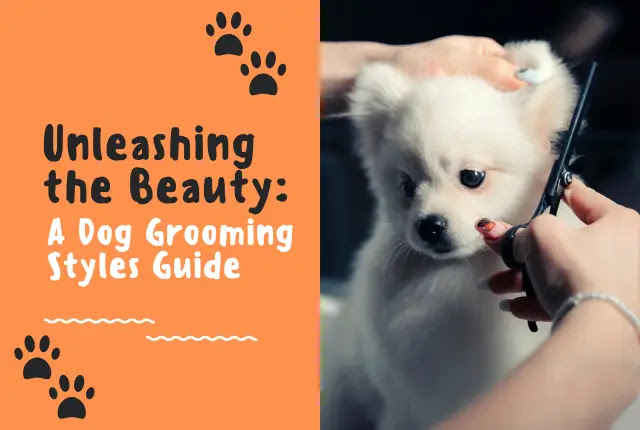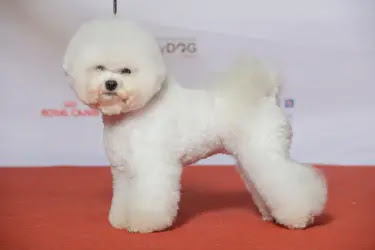Dog grooming is an important aspect of pet care that helps to keep your dog healthy, happy, and looking its best. Whether you're looking to give your furry friend a new look or simply keep their coat healthy, our guide will help you understand the different dog grooming styles available. From short-haired breeds to long-haired breeds, we've got all the information you need to choose the right style for your pup. With our comprehensive guide, you'll learn about the different types of grooming cuts for dogs, how to choose the perfect haircut for your furry friend, and which breeds should not be groomed. So, let's get started and unleash the beauty of your dog with our dog grooming styles guide."
1. Grooming Styles for Short-Haired Dogs
- Short and Sleek: This style is a simple, short cut that is easy to maintain and perfect for dogs that are prone to matting.
- Puppy Cut: This style is similar to the short and sleek, but it leaves a little more length on the body and legs for a more playful look.
- Teddy Bear Cut: This style is a shorter cut that leaves a bit more length on the face, giving your dog a cute, teddy bear-like appearance.
- Lion Cut: This style is a dramatic cut that leaves a mane of longer hair around the neck and shoulders while the rest of the body is shaved short.
- The Short and Sassy Cut: This style is a short cut that is shaped and sculpted to give your dog a stylish, sassy look.
2. Grooming Styles for Long-Haired Dogs
- The Long and Luscious: This style is a full, long cut that is perfect for breeds with long, silky coats.
- The Topknot: This style involves tying the hair on top of the head into a bun or ponytail, which helps to keep the hair out of the dog's face.
- The Fluffy and Fun: This style is a long cut that is fluffed and shaped to give your dog a playful, fluffy look.
- The Elegant Topknot: This style is similar to the regular topknot, but it's more refined and elegant, perfect for formal events or photo shoots.
- The Tangle-free Tresses: This style is a long cut that is trimmed and shaped to minimize tangling and matting.
3. Grooming Styles for Mixed-Breed Dogs
- The Mixed-breed Mop: This style is a long, shaggy cut that is perfect for dogs with thick, wiry coats.
- The Mixed-breed Bob: This style is a short, layered cut that is easy to maintain and perfect for dogs with thick, coarse coats.
- The Mixed-breed Shag: This style is a medium-length cut that is perfect for dogs with a combination of long and short hair.
- The Mixed-breed Pouf: This style is a short cut that is shaped and sculpted to give your dog a playful, poufy look.
- The Mixed-breed Scruff: This style is a short cut that is trimmed and shaped to give your dog a scruffy, rugged look.
4. Grooming Styles for Specific Dog Breeds
Specific dog breeds have certain characteristics and grooming needs that should be taken into consideration when choosing a grooming style. Some popular grooming styles for specific dog breeds include:
- Poodle Cuts: Poodles have a variety of coat types and lengths, so there are many different grooming styles to choose from, including the Puppy Cut, Continental Cut, and English Saddle Cut.
- Bichon Frise Cuts: Bichon Frise has a thick, curly coat that requires regular grooming to prevent matting. Popular grooming styles for Bichon Frise include the Bichon Frise Teddy Bear Cut and the Bichon Frise Topknot.
- Shih Tzu Cuts: Shih Tzu has a long, silky coat that requires regular grooming to prevent matting. Popular grooming styles for Shih Tzu include the Shih Tzu Topknot and the Shih Tzu Fluffy and Fun Cut.
- Maltese Cuts: Maltese has a long, silky coat that requires regular grooming to prevent matting. Popular grooming styles for Maltese include the Maltese Topknot and the Maltese Long and Luscious Cut.
- Yorkie Cuts: Yorkies have a fine, silky coat that requires regular grooming to prevent matting. Popular grooming styles for Yorkies include the Yorkie Topknot and the Yorkie Short and Sassy Cut.
5. Grooming Tools and Products
Different grooming styles require different tools and products to achieve and maintain. Some basic tools and products that are needed for dog grooming include scissors, clippers, combs, brushes, shampoo, and conditioner. It's important to select high-quality tools and products that are suitable for your dog's coat type and grooming needs.What are the different types of grooming cuts for dogs?
When it comes to grooming cuts for dogs, there are three main types to consider:
- Scissor cuts: done with scissors and are typically used to shape and sculpt the coat. This method is commonly used for breeds with long or medium-length hair and is ideal for creating a specific look or style.
- Clipper cuts: done with electric clippers and are typically used for breeds with short hair. This method is commonly used for breeds like Bulldogs, Boxers, and Pit Bulls.
- Hand-stripped cuts: done with a stripping knife or stripping stone and are typically used for breeds with a coarse, wiry coat. This method is commonly used for breeds like Cairn Terriers, Airedale Terriers, and Welsh Terriers. It's important to consider the coat type and breed of your dog when choosing a grooming cut to ensure a suitable and comfortable grooming experience for your pet.
How do I choose a haircut for my dog?
Choosing a haircut for your dog can be a bit challenging, but it's important to consider the individual needs of your pet, their coat type, and their lifestyle. Some things to consider when choosing a haircut for your dog include:
- Coat type: The type of coat your dog has will determine the type of cut that is most suitable for them. Dogs with long or medium-length hair will typically need a scissor cut, while dogs with short hair will typically need a clipper cut. Dogs with a coarse, wiry coat may need a hand-stripped cut.
- Breed: Certain breeds have specific grooming needs. For example, Poodles have a variety of coat types and lengths, so they can have many different grooming styles. On the other hand, Bichon Frise has a thick, curly coat that requires regular grooming to prevent matting.
- Lifestyle: The lifestyle of your dog should also be considered when choosing a haircut. For example, if your dog is a working dog, it may need a shorter cut that is easier to maintain. If your dog is a show dog, it may need a more specific, elaborate cut that conforms to breed standards.
- Personal preference: Ultimately, the cut you choose for your dog should be one that you are happy with and that makes your dog look and feel their best.
It may be a good idea to speak with a professional groomer to get an expert opinion on what would be the best cut for your dog, they can also give you a demonstration of how the cut will look on your dog and give you tips on how to maintain it.
What dog breeds should not be groomed?
Some dog breeds should not be groomed due to their specific characteristics and needs. These breeds include:
- Hairless breeds: Breeds such as the Chinese Crested, the American Hairless Terrier, and the Peruvian Inca Orchid, have very little or no hair at all, so they do not require grooming.
- Breeds with sensitive skin: Some breeds, such as the Bulldog, have sensitive skin and can be easily irritated by grooming tools. It is important to use gentle tools and products when grooming these breeds.
- Breeds with double coats: Some breeds, such as the German Shepherd and the Golden Retriever, have a double coat, which means they have a soft undercoat and a coarser outer coat. Grooming these breeds improperly can cause damage to their coat and skin. It is important to seek the guidance of a professional groomer when grooming these breeds.
It is important to consult with a veterinarian or professional groomer before grooming any dog, they can help you determine if it is safe to groom a specific breed or if you should avoid it due to any of the above reasons.
What dog breed is hardest to groom?
Different dog breeds have different grooming needs and some may be considered harder to groom than others. Some of the breeds that are considered to be the hardest to groom include:
- Afghan Hound: This breed has a long, silky coat that requires regular grooming to prevent matting. The coat is also prone to tangling, which can make grooming difficult.
- Pomeranian: This breed has a thick, fluffy coat that requires regular grooming to prevent matting. The coat is also prone to tangling, which can make grooming difficult.
- Shih Tzu: This breed has a long, silky coat that requires regular grooming to prevent matting. The coat is also prone to tangling, which can make grooming difficult.
- Lhasa Apso: This breed has a long, thick coat that requires regular grooming to prevent matting. The coat is also prone to tangling, which can make grooming difficult.
- Bichon Frise: This breed has a thick, curly coat that requires regular grooming to prevent matting. The coat is also prone to tangling, which can make grooming difficult.
It's important to note that the difficulty of grooming a dog depends on the skill of the groomer, the dog's coat type, and its condition. A professional groomer will have the experience and knowledge to groom these breeds effectively. It is also important to groom your dog regularly to keep its coat healthy and to make grooming easier.
What is the hardest part of dog grooming?
The hardest part of dog grooming can vary depending on the breed, coat type, and skill of the groomer. Some common challenges that groomers may face include:
- Dealing with matting: Matting is a common issue that can occur when a dog's coat is not groomed regularly. Matting can be uncomfortable for the dog and can lead to skin irritation and infection.
- Dealing with tangles: Tangles can be difficult to remove, especially in breeds with long or thick coats. Tangles can be uncomfortable for the dog and can lead to matting and skin irritation.
- Dealing with sensitive skin: Some breeds have sensitive skin that can easily be irritated by grooming tools and products. It's important to use gentle tools and products when grooming these breeds.
- Dealing with difficult behaviors: Some dogs may not enjoy being groomed and may have difficult behaviors such as biting or scratching. It's important to have patience and to work with the dog to help them relax and feel comfortable during the grooming process.
It's important to note that a professional groomer will have the experience and knowledge to overcome these challenges. They will also have the right tools and products to groom the dogs safely and effectively. Additionally, regular grooming will prevent many of these issues from happening.




